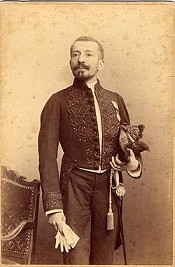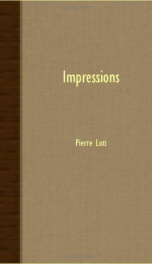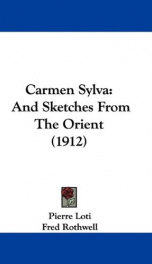Loti Pierre

Pierre Loti (pseudonym of Julien Viaud), born January 14, 1850 in Rochefort, Charente-Maritime and died June 10, 1923 in Hendaye, was a French novelist and naval officer. [1] Loti's education began in Rochefort. At the age of seventeen he entered the naval school in Brest and studied on Le Borda. He gradually rose in his profession, attaining the rank of captain in 1906. In January 1910 he went on the reserve list. His pseudonym is said to refer to his extreme shyness and reserve in early life, which made his comrades call him after "le Loti" (lotus), an Indian flower which allegedly loves to blush unseen. Other explanations have been put forth by scholars: for instance, that he acquired the name in Tahiti, where he got a sunburn and was called Roti (a red-colored local flower), but couldn't pronounce the "r" so he stuck with "Loti". He was in the habit of claiming that he never read books, saying to the Académie française on the day of his introduction (April 7, 1892), "Loti ne sait pas lire" ("Loti doesn't know how to read"), but testimony from friends says otherwise. Le Mariage de Loti (1880) was the first book to introduce him to the general reading public. This was followed by Le Roman d'un spahi (1881), a record of the melancholy adventures of a soldier in Senegal. In 1882, Loti issued a collection of four shorter pieces, three stories and a travel piece, under the general title of Fleurs d'ennui (Flowers of Boredom). In 1883 he entered a wider public spotlight. First, he published the critically acclaimed Mon frère Yves (My Brother Yves), a novel describing the life of a French naval officer (Pierre Loti), and a Breton sailor (Yves Kermadec), described by Edmund Gosse as "one of his most characteristic productions". Second, while serving in Tonkin (northern Vietnam) as a naval officer aboard the ironclad Atalante, Loti published three articles in the newspaper Le Figaro in September and October 1883 about atrocities that occurred during the Battle of Thuan An (20 August 1883), an attack by the French on the Vietnamese coastal defenses of Hue. He was threatened with suspension from the service for this indiscretion, thus gaining wider public notoriety. In 1886 he published a novel of life among the Breton fisherfolk, called Pêcheur d'Islande (Iceland Fisherman), which Edmund Gosse characterized as "the most popular and finest of all his writings."[1] It shows Loti adapting some of the Impressionist techniques of contemporary painters, especially Monet, to prose, and is a classic of French literature. In 1887 he brought out a volume "of extraordinary merit, which has not received the attention it deserves", Propos d'exil, a series of short studies of exotic places, in his characteristic semi-autobiographic style. Madame Chrysanthème, a novel of Japanese manners that is a precursor to Madame Butterfly and Miss Saigon (a combination of narrative and travelog) was published the same year.[2] In 1890 he published Au Maroc, the record of a journey to Fez in company with a French embassy, and Le Roman d'un enfant (The Story of a Child), a somewhat fictionalized recollection of Loti's childhood that would greatly influence Marcel Proust. A collection of "strangely confidential and sentimental reminiscences", called Le Livre de la pitié et de la mort, (The Book of Pity and Death) was published in 1891. Loti was on shipboard at the port of Algiers when news reached him of his election, on May 21, 1891, to the Académie française. In 1892 he published Fantôme d'orient, a short novel derived from a subsequent trip to Istanbul, less a continuation of Aziyadé than a commentary on it. He described a visit to the Holy Land in three volumes, The Desert, Jerusalem, and Galilee, (1895–1896), and wrote a novel, Ramuntcho (1897), a story of contraband runners in the Basque province, which is one of his best writings. In 1898 he collected his later essays as Figures et Choses qui passaient (Passing Figures and Things). In 1899 and 1900 Loti visited British India, with the view of describing what he saw; the result appeared in 1903 in L'Inde (sans les Anglais) (India (without the English)). During the autumn of 1900 he went to China as part of the international expedition sent to combat the Boxer Rebellion. He described what he saw there after the siege of Beijing in Les Derniers Jours de Pékin (The Last Days of Peking, 1902). Among his later publications were: La Troisième jeunesse de Mme Prune (The Third Youth of Mrs. Plum, 1905), which resulted from a return visit to Japan and once again hovers between narrative and travelog; Les Désenchantées (The Unawakened, 1906); La Mort de Philae (The Death of Philae, 1908), recounting a trip to Egypt; Judith Renaudin (produced at the Théâtre Antoine, 1898), a five-act historical play that Loti presented as based on an episode in his family history; and, in collaboration with Emile Vedel, a translation of King Lear, produced at the Théâtre Antoine in 1904. Les Désenchantées, which concerned women of the Turkish harem, was based like many of Loti's books, on fact. It has, however, become clear that Loti was in fact the victim of a cruel hoax by three prosperous Turkish women.[3] He produced a play at the Century Theatre in New York City in 1912, The Daughter of Heaven, which had been written several years before in collaboration with Judith Gautier for Sarah Bernhardt. He died in 1923 at Hendaye and was interred on the Île d'Oléron with a state funeral. Loti was an inveterate collector, and married into the money that helped him support this habit. His house in Rochefort, a remarkable reworking of two adjacent bourgeois row houses, is well preserved as a museum. One elaborately tiled room is an Orientalist fantasia of a mosque, including a small fountain and five ceremoniously draped coffins (with the desiccated bodies inside). Another room evokes a medieval banqueting hall. Loti's own bedroom is rather like a monk's cell, but mixes Christian and Muslim religious artifacts. The courtyard described in The Story of a Child, with the fountain built for him by his older brother, is still there. Contemporary critic Edmund Gosse gave the following assessment of his work:[1] At his best Pierre Loti was unquestionably the finest descriptive writer of the day. In the delicate exactitude with which he reproduced the impression given to his own alert nerves by unfamiliar forms, colors, sounds and perfumes, he was without a rival. But he was not satisfied with this exterior charm; he desired to blend with it a moral sensibility of the extremest refinement, at once sensual and ethereal. Many of his best books are long sobs of remorseful memory, so personal, so intimate, that an English reader is amazed to find such depth of feeling compatible with the power of minutely and publicly recording what is felt. In spite of the beauty and melody and fragrance of Loti's books his mannerisms are apt to pall upon the reader, and his later books of pure description were rather empty. His greatest successes were gained in the species of confession, half-way between fact and fiction, which he essayed in his earlier books. When all his limitations, however, have been rehearsed, Pierre Loti remains, in the mechanism of style and cadence, one of the most original and most perfect French writers of the second half of the 19th century. With regards to Pierre Loti's support for the Turkish Independence War, the Council of Ministers had sent him a gratitude message.[4] In spite of his oriental views he received critical reception from Turkish intellectuals. According to famous communist poet Nazım Hikmet he was pitying the sorry state of backward Ottoman Empire. In a 1925 poem named Şarlatan Piyer Loti (Charlatan Pierre Loti) he wrote: Official Sources Commentary
do you like this author?
What readers are saying
What do you think? Write your own comment on this book!
write a commentWhat readers are saying
What do you think? Write your own comment on this author!
write a commentBook list

Aziyadé
Extrait des notes et lettres d'un lieutenant de la marine anglaise entré au service de la Turquie le 10 mai 1876 tué dans les murs de Kars,le 27 octobre 1877.
Series:
Unknown
Year:
Unknown
Raiting:
3.5/5
Show more
add to favoritesadd In favorites
Book list

Aziyadé
Extrait des notes et lettres d'un lieutenant de la marine anglaise entré au service de la Turquie le 10 mai 1876 tué dans les murs de Kars,le 27 octobre 1877.
Series:
Unknown
Year:
Unknown
Raiting:
3.5/5
Show more
add to favoritesadd In favorites

Les Désenchantées — Roman des harems Turcs contemporains
Series:
Unknown
Year:
Unknown
Raiting:
3/5
Show more
add to favoritesadd In favorites

jerusalem
Series:
Unknown
Year:
Unknown
Raiting:
3/5
There are many books on the Holy Land, but not one that has in it anything such as Loti has put into this nor one that makes Christ seem so real, and yet the author professes to be an unbeliever. It has an extraordinary charm and fascination, and believers and unbelievers alike will appreciate it. --This text refers to the Hardcover edition.
Show more
add to favoritesadd In favorites

india
Series:
Unknown
Year:
Unknown
Raiting:
3.5/5
Loti´s idea in going to India was to discover if in the Buddhist faith he could find anything to replace the Catholic religion in which he could no longer believe. He visits the ruined temples of the ancient Gods, listens to the languorous Oriental music on the moonlight nights; he experiences nameless dreads, indescribable terrors. --This text refers to the Hardcover edition.
Show more
add to favoritesadd In favorites

impressions
Series:
Unknown
Year:
Unknown
Raiting:
4/5
IMPRESSIONS -- Pierre Loti - MAY as well admit at the outset that in speaking of Pierre Loti I give way to an inclination of the irresistible sort, express indeed a lively obligation. I am conscious of owing him that amount and that kind of pleasure as to which hesitation resides only in the difficulty of statement. He has been for me, from the hour of my making his - ac-quaintance, one of the joys of the time, and the fact moreover of his being of the time has often, to my eyes, made it seem to suffer less from the presence of writers less delightful yet more acclaimed. It is a part of the joy I speak of that, having once for all, at the beginning, caused the critical sense thoroughly to vibrate, he has ever since then let it alone, brought about in my mind a state of acceptance, a state of gratitude, in which I have been content not to discriminate. Critically, on first knowing him, I surrendered-for it has always seemed to me that the inner chamber of taste opens only to that key but, the surrender being complete-the chamber never again closed-I feel that, like King Amasis with the ring, I have thrown the key into the deep. He is extremely unequal and extremely imperfect. He is familiar with both ends of the scale of taste. I am not sure even that on the whole his talent has gained with experience as much as was to have been expected, that his earlier years have not been those in which he was most to endear himself. But these things have made little difference to a reader so committed to an affection. It has been a very simple case. At night all cats are grey, and I have liked him so much in general that there has always been a perch, a margin left when the special case has for the moment cut away a little of the ground. The love of letters renders us no greater service-certainly opens to us no greater satisfaction-than in putting us from time to time under some such charm. There need never be a fear, I think, of its doing so too often. When the charm, in such a manner, fixes itself, what has happened is that the effect, the operative gift, has become to us simply a value, and that an experience more or less bitter has taught us never, in literature, to sacrifice any value we may have been fortunate enough to light upon. Such discoveries are too happy, such values too great. They do for us what nothing else does. There are other charms and other surrenders, but those have their action in another air. What the mind feels in any form of magic is a particular extension of the contac with life, and no two forms give us exactly the same. Every artist who really touches us becomes in this way an individual instrument, the fiddler, the improviser of an original tune. The inspiration may sometimes fail, the notes sound weak or false but to break, on that account, the fiddle across ones knee is surely-given, as we look about the much-mixed field, the other cc values -a strange aesthetic economy. I read and relish him whenever he appears, but his earlier things are those to which I most return. It took some time, in those years, quite to make him out-he was so stranpe a mixture for readers of our tradition. He V , was a sailor-man and yet a poet, a poet and yet a sailorman. To a ma ked division of these functions we had always been accustomed, looking as little for sensibility in the seaman as perhaps for seamanship in the man of emotion. So far as we were at all conscious of the uses of sensibility it was not to the British or the American tar that we were in the habit of applying for it...
Show more
add to favoritesadd In favorites

carmen sylva and sketches from the orient
Series:
Unknown
Year:
Unknown
Raiting:
3.5/5
Purchase of this book includes free trial access to www.million-books.com where you can read more than a million books for free. This is an OCR edition with typos. Excerpt from book: of superior essence. I could not use the word angel, which, through misuse, has become antiquated and ridiculous. Moreover, the word fairy, interpreted as I understand it, seems to me quite applicable to this woman youthful in spite of her grey locks; smiling through a mist of tears; a daughter of the North and yet a queen of the Orient; speaking many languages and transforming each into perfect music; ever fascinating, possessing the gift of creating around her sometimes merely by the aid of a genial smile a kind of beneficent charm, of the most reassuring and consoling nature. Thus do I call back to mind the queen with her flowing veil (no longer dare I speak of the fairy, now that I have defined her more openly). She is speaking to me as she sits before her easel, whilst archaic drawings, which seem the natural offspring of her fingers, succeed one another on the parchment of the missal. By the side of Her Majesty sit two or three young ladies, her maids of honour, dark-complexioned girls wearing strange-coloured gold-spangled Oriental costumes; they are engaged either in reading,or in embroidering on silk large, old-fashioned flowers. They raise their eyes from time to time, whenever the conversation appears to interest them more particularly. The place Her Majesty generally appoints for me is in front of herself, near a large single-paned window, which offers the illusion of opening out upon the surrounding forest. With true artistic feeling, the king had allowed the forest to approach within twenty paces of the walls; the result being that the windows of the royal apartments look upon nothing but gigantic firs and undergrowth, or wide-spreading verdant stretches, the sylvan peaks of the Carpathians rising tier upon tier in the limpid atmosphere. And the forest, ... --This text refers to an alternate Paperback edition.
Show more
add to favoritesadd In favorites

a spahis love story from the french of pierre loti pseud frontispiece
Series:
Unknown
Year:
Unknown
Raiting:
4/5
Show more
add to favoritesadd In favorites

a memorial of closing scenes in the life of rev george b little
Series:
Unknown
Year:
Unknown
Raiting:
3/5
Show more
add to favoritesadd In favorites

The Story of a Child
Series:
Unknown
Year:
Unknown
Raiting:
2.5/5
Translated by Caroline F. Smith
Show more
add to favoritesadd In favorites
What readers are saying
What do you think? Write your own comment on this author!
write a commentif you like Loti Pierre try:
readers also enjoyed
What readers are saying
What do you think? Write your own comment on this author!
write a commentGenre
if you like Loti Pierre try:
readers also enjoyed
Do you want to read a book that interests you? It’s EASY!
Create an account and send a request for reading to other users on the Webpage of the book!



